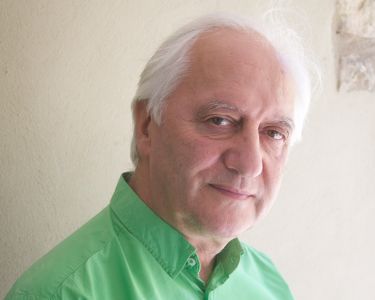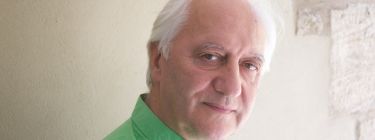
Riding the rapids of the great transformation
Charles Landry, inventor of Creative City concept and Co-Founder Creative Bureaucracy Festival, Berlin
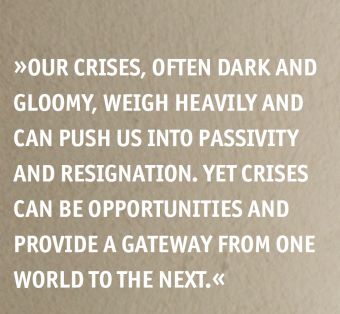
Riding the rapids of the great transformation
The place to be
Periods of history involving mass transformation, like the Enlightenment, the Industrial Revolution or the technological revolution of the past fifty years are cultural shifts. They involve major adjustments in attitudes, ways of being and mindset. They can produce confusion yet also a sense of liberation and a mindshift combined with a feeling of being swept along by events. There were delights and dilemmas as they unfolded. Now, by contrast, the temper of the age, the Zeitgeist, is one of uncertainty, foreboding, vulnerability and lack of control over overweening global forces—especially our urgency to avert climate collapse or to avoid the polarising narratives that poison civilised conversation.
It is hard to see a way to a golden age, especially since we know we need to shift our economic order and a way of life that is materially expansive, socially divisive and environmentally hostile. And doing that cannot be grasped by a business-as-usual approach as it takes a while for new ethical stances and new ways of operating to take root and to establish a new and coherent world view.
Is there light at the end of the horizon in facing those challenges, even though some feel Europe is at the edge of exhaustion and without the energy or motivation to think, plan and act afresh and with vigour? Is that really so?
Will-o'-the-wisps?
Our crises, often dark and gloomy, weigh heavily and can push us into passivity and resignation. Yet crises can be opportunities and provide a gateway from one world to the next. Take a helicopter view of the vast range of initiatives happening, large and small, across Europe and beyond to address the solutions to create a more human- and nature-centred world and you see some positive patterns. Still, for the moment, fragmented and without sufficient power and traction, big agendas are coming together in unprecedented ways and driving this change are many: activists, civil society, politicians, researchers, inventors, artists, entrepreneurs, business, writers and more. There is a mood and a movement emerging. We are seeing the possibility of creating a different world driven on other principles. There is a Planet B in sight, even though to get there we must get Planet A right.
It is a compelling story. Think how eco-principles are beginning to shape our mindset and how that provides the frame and therefore
courage to move towards a green transition where the circular economy notion plays a crucial part. Think too how newer concepts like resilience help us work through the tasks ahead or how co-creation and the participatory imperative helps harness the collective imagination (since transformation is a collective endeavour). Think here too of the notion that the world is our commons. And not to forget a digitising world that allows, in particular, the cultural creative economy to run through systems like electricity in its inventiveness and with its immersive capacities. Sometimes the speed of the possibilities are dizzying and we always must be alert that we, rather than the technologies, are in control.
There is convergence and it is happening at escalating speed. From the beginning of the 21st century we finally saw a rapprochement between the two great ways of exploration, discovery and knowing: Art and Science. That rapprochement began to break down the widespread mutual incomprehension between the arts and sciences. The premise is that the most fruitful
developments in human thinking frequently take place at those points where different lines of creativity meet. By sharing their creativities, ways of knowing and the knowledge it enables, scientists and artists enrich and maximise each other’s potential and so encourage innovation. The transdisciplinary perspective is powerful when boundaries erode and as the methods of exploration and problem-solving can combine the linear, analytical and logical as well as the visual, kinaesthetic, spatial and musical. Allied to technologies that help shift ideas into reality, these synergies promote new forms of creativity which can result in ideas that can be turned successfully into products, services and solutions. This is the radical technological and cultural revolution underway. It has great opportunities. Together it is all transformative.
Incessantly, however, a bigger question remains ever-present and it needs to be answered: How do you make people feel viscerally that they must transform and change their minds—even while people realise that the world stands at the cusp of a crucial moment? Time is short in which to make the big difference towards one-planet living and we need to harness and share our collective talents, will, energy, intelligence and resources.
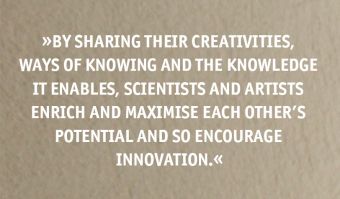
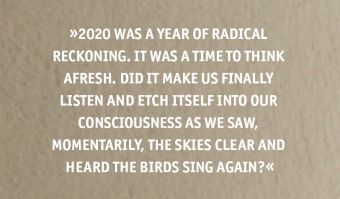
The year 2020 glitch
2020 was a year of radical reckoning. It was a time to think afresh. Did it make us finally listen and etch itself into our consciousness as we saw, momentarily, the skies clear and heard the birds sing again? This forced experiment of reducing carbon emissions gave us a glimpse of a possible other world. It reminded us that the world of ‘more and more’ cannot go on even though many still think of the old normal as our desirable and exotic destination. Crises like the pandemic provoke a dramatic reordering of priorities, deep reflection and rethinking and focused us—or at least should have—on what really matters: the common good and public interest. We saw too that, as Tom Burke put it, “civilisation is the thin film of order around the chaos of events.”
The pandemic was a wake-up call which triggered a dawning of humility as our collective hubris was humbled and old certainties crumbled. The pandemic created both clarity and confusion as in the eye of the storm it is difficult to see “where next” and how to get there. There seems to be no blueprint for how to move forward, yet we do have them.
We have an image of what could be: a zero-carbon society, a gender-equal society, a world where the dividends rather than the threats of diversity are promoted. The solutions are there but we think too often that technology will sort it out and that we can continue to just act as before. Technology takes on the responsibility and authority. We abnegate, we feel less answerable to what is happening. Shifting our mindset and how we think, plan and act—our behaviour—is the far bigger task.
Taking an eagle-eye view of the world in motion demands we unscramble the nested complexities and look at existing trends in order to assess their depth or superficiality, their characteristics and the nature of their impacts.
A good analogy is to think of change like an ocean. Ripples on the surface are less important than waves of increasing significance, which are themselves formed by tides, currents, climatic changes and
geological events which shape the movement and dynamics of the whole—and which might produce the occasional tsunami. It is that tsunami we need to avert.
We know the direction of travel if we do not act and it is the deep trends—think climate change—that we need to address. The challenge for all of us is to distinguish between the important, the less significant and the trivial: to understand the difference between a trend and a fad. And some trends are as persistent as they are predictable—just consider that when I was born the world population was about 2 ½ billion and when I die it will be more than 8 billion people. Not surprisingly, nature is suffering. Think water shortages, deforestation and animal extinctions. All are inextricably interwoven. In addition to this we are still operating largely with the same institutional structures made for a different age.
Variation of the mind
To make the rebirth—perhaps a Renaissance—a reality requires us to shift our mindset dramatically. That mindset should see things as an integrated whole. But this is not to downgrade the specialist—it is simply that we need to grasp the interconnections. Is it crisis, danger, the fear of impending doom, awareness, knowledge or is it a thoughtful, inclusive mind that shifts our thinking? This means understanding mindsets, mindflows and mindshifts. It implies reassessing how we think and learn, what we learn, the intelligences harnessed, the types of information used and disregarded. It demands new criteria to discriminate, judge and filter and a broader perspective which embodies a more inclusive sense of possible resources that are more free-flowing, lateral and creative. A changed mindset, rethought principles, new ways of understanding and generating ideas are the cornerstones of change.
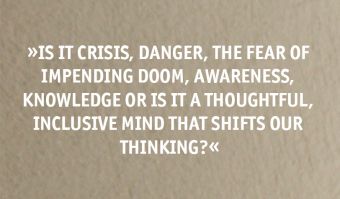
A mindset is the order within which people structure their worlds and how they make choices, both practical and idealistic, based on values, philosophy, traditions, experience and aspirations. Mindset is our accustomed, convenient way of thinking and guide to decision-making. It not only determines how we act in our small local world, but also how we think and act on an ever-encompassing stage. Mindset is the settled summary of our prejudices and priorities and the rationalisations we give them. A changed mindset is a re-rationalisation of a person’s behaviour and is difficult as people like their behaviour to be coherent—at least to themselves.
Mindflow is the mind in operation. The mind is locked into certain patterns for good reason. To cope with the world we focus on the familiar, whether thought processes, attitudes, concepts and interpretations. The environment or context determines what is seen and what meaning is given. It operates below the level of conscious awareness. We cannot be completely open 24/7 although our default position must be a willingness to re-assess. Most of us will look at the world or a problem in a learnt way and have vested interests in perpetuating our current practices. An open focus can be seen as threatening, especially for discipline specialists as this might challenge the authority of their profession.
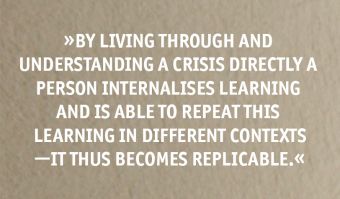
A mindshift is the process of dramatically reassessing core ideas. But how can you relax when there are pressures around you? Changing a mindset is unsettling and potentially frightening. Transformative effects happen in differing degrees: direct experience, seeing things work and fail and through conceptual knowledge. The most powerful means is the direct experience of having to change behaviour. This is where crisis comes in. By living through and understanding a crisis directly a person internalises learning and is able to repeat this learning in different contexts—it thus becomes replicable.
The challenge here Is that we travel with a weight of history attuned to bipolar thinking, operating in silos and are often sceptical of integrated, 360-degree perspectives and transdisciplinary thinking. Yet that cannot generate the solutions the future requires. The greater the number of perspectives applied to a problem, the more
imaginatively will it be approached. This is not to deny the value of our existing specialist knowledge. We cannot all simultaneously have the skills of an engineer, a biochemist or environmentalist, but we can understand their essence and so merge them with other skills or insights to make them more effective. This integration with other skills—especially in the human and social sciences, such as history, anthropology, sociology and psychology—has too often been lost in most affairs. For instance, a traffic issue is never only about cars and land use. If transport planners had understood psychology or culture better or the ideas of mental geography, they would have been more careful about building urban motorways that scorch their route through communities.
So, how can youthink small and with less when we are used to thinking big and with more? This transformation is a cultural project, the biggest of our times, as it is about values, mindset, attitudes and hearts, minds and skills. Seeing things culturally is powerful as culture is who we are. Creativity helps shape what we can become.
There are various ways to change behaviour and mindset: to coerce through force or regulation; to induce through payment or incentives; to convince through argument; to con, fool or trick people; to seduce (an odd combination of the voluntary and involuntary); and finally to create and publicise aspirational models. It is the latter we need to
focus on and it is not as straightforward as it sounds. It is likely to be a combination of all persuasive devices that takes into account immediate, short- and long-term impacts. At times the slowest way of changing a mindset can be by rational argument; yet while longer, it is the most effective, especially when evidence based.
This is where storytelling comes in and understanding the distinction between forms of communication—especially the narrative and iconic. Narrative communication is concerned with creating arguments; it takes time and promotes reflection and is linked to critical thinking; we build understanding piece by piece. Iconic communication by contrast seeks to ‘squash meaning’ and to crisply encapsulate an essence in order to create high impact and to show that what is being said feels significant. Our challenge is to embed narrative qualities and deeper, principled understandings within projects which have iconic power. This is where the talents embedded within the creative economy are so significant. They can create the messaging, the products, the experiences that are emblematic and which can leapfrog learning and avoid lengthy explanatory narratives through the force of their ideas, their projects and the symbolism they engender. The iconic project says it in one go and as you reflect, you understand what it is about.
How artists and those in the creative economy can help
What exactly is it about the process and act of singing, writing, dancing, acting, performing music, sculpting, painting, designing or drawing that is so special? Participating in these activities arguably harnesses the imaginary realm to a degree that other disciplines such as sports or much of science, which are more rule-bound and precise, do not. The latter tend to be ends in themselves, they do not change the way you perceive society; they tend to teach you something specific. This process of imagining has the benefit of forcing us to reflect, to develop original thought, to confront challenges and, crucially, to imagine that Planet B, which is where we need to get to. Nursing us through a green transition is a creative act where involvement with the arts can help.
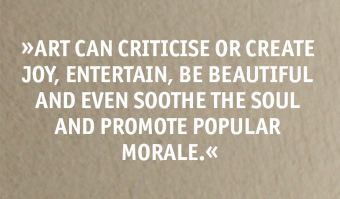
Engagement with the creative activities combines both stretching oneself and focusing; feeling the senses and expressing emotion. Art, for instance, can broaden horizons and convey meaning with immediacy as well as depth; it can facilitate immediate and profound communication; symbolise complex ideas and emotions or encapsulate previously scattered thoughts; anchor identity and enhance communal bonds or, conversely, stun and shock for social, moral, or thought-provoking ends. Art can criticise or create joy, entertain, be beautiful and even soothe the soul and promote popular morale. More broadly, expression through the arts is a way of passing ideas and concepts on to later generations in a (somewhat) universal language.
What art does is not a linear process. Humans are largely driven by their sensory and emotional landscape in spite of centuries of developing scientific knowledge and logical, analytical, abstract and technical thought. We are not rational in a scientific sense, but we are a-rational rather than irrational. This is why all cultures develop arts.
What are the elements that help transformation along the way? We see here a combination of urgency, perhaps a crisis, and increasing evidence that the old ways do not work. Then a new concept comes in that encapsulates a way forward, as when the notion of sustainability emerged especially after the Club of Rome report in 1972. That in turn can drive an intent, a vision, a mission. Missions act as calls to action and as gathering devices to bring interests together towards a common aim. Crucially, we need real-life projects that embed the intent as it is only the lived experience of, say, a sustainability
initiative in action that makes an abstract concept real. Think here of the 15-minute city idea popularised by Paris and its focus on the city of proximity where walking, ease of access and most facilities are nearby and local. Here what might have seemed invisible becomes visible.
This reminds us that the new thinking needs to impact at three levels—the conceptual, the discipline-based and the implementational. It involves, additionally, reviewing the detailed mechanisms to make things happen, such as financial arrangements or planning codes to encourage and direct development into certain directions.
New thinking can generate a rebirth—a Renaissance. This Renaissance could unleash a process of re-enchantment that speaks to our deepest yearnings, our soul and our sense of wanting to become whole again where we and the world around us have the right balance.
Great placemaking is an art not a formula, but strong principles can help us along the way. For a long time I pondered, What are great places beyond their need to provide the means of survival and shelter and to be environmentally responsible? Five core themes came to mind: “places of anchorage and distinctiveness”, “places of connection and communication”, “places of opportunity and ambition”, “places of nurture and nourishment” and “places of inspiration and imagination”.
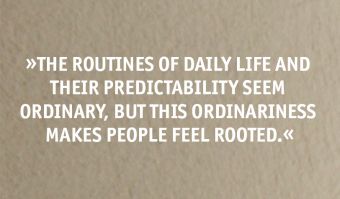
A place of anchorage and distinctiveness
This place feels like home. It generates a sense of the known, it is familiar and comforting, it feels safe and this is a place where I am sheltered and that creates a sense of belonging. It is distinctively itself. It celebrates where it comes from. It acknowledges its past, its heritage, its traditions and core assumptions about who it is. Its multiple identities, its ideas, its visions are etched into its way of life and this is what makes it special and unique. This place explains to itself where it comes from by its history, built fabric and urban design, its rituals, behaviours and activities. The routines of daily life and their predictability seem ordinary, but this ordinariness makes people feel rooted. Ironically, feeling at ease about itself gives this place confidence about where it is going and more relaxed about any changes that may unfold—so it dares to be innovative.
A place of connection and communication
This is a place of relationships, from the incidental to the casual to the deeply profound. You connect and communicate face to face with neighbours, work colleagues, friends, acquaintances and those different from you. You link to the wider world physically and digitally as well as with your past and potential futures.This place is locally bonded. It is at ease with itself and with the wider world. It reaches out. It is relaxed about meshing its diversities. There is seamless connectivity enabled by high quality urban design, good gathering places and possibilities for chance encounter. Its walkability and varied transport modes—internally- and externally-focused—connect beyond the city confines. Its digital infrastructures reach out to virtual worlds stretching out far and wide. It is the hub from which your transactions with the world flow—both those near to you and those afar.
A place of opportunity and ambition
This place fosters open-mindedness. It encourages a culture of curiosity, it provides choices, options and possibilities in our differing phases of life. It has a ‘can do’ attitude. There is an experimental culture and this keeps it flexible and adaptive to emerging circumstances and changes.Some places provide opportunities and others less so, yet this is a place in which to have ambition, ideals and aspiration. It sparks in you the desire to give free rein to your exploratory instinct and to open out. The raw materials of the city create the potential and are embodied in peoples’ creativity, skills and talents as well as its material resources. These are “things” like buildings and also symbols, activities and the repertoire of local products in crafts, manufacturing and services. They are our historical, industrial and artistic assets including architecture, urban landscapes and landmarks as well as our indigenous traditions of public life, festivals, rituals and stories, hobbies, enthusiasms and amateur cultural activities. This draws attention to the distinctive, unique and the special in any place. These resources are all potential opportunities. Acknowledging this can engender a spirit of generosity. It can create the desire to give back to your city. This helps generate civic pride, loyalty and trust.
A place of nurture and nourishment
In this place people can flourish and there are many opportunities to self-improve from the formal to the informal. This is a lifelong learning environment and a place where a culture of discussion is vibrant. This place cares about every aspect of your life. Here you can grow personally and professionally and the city helps you in this endeavour. It reinforces your necessary ladders of opportunity to move forward. It provides accessibility and enables mobility and helps move away constraints. It enables you to be more fulfilled and to widen your horizons. You are fed by these broadening perspectives and so learn and reflect. This can help citizens become more competent and confident and thus willing to participate in helping to shape, make and co-create their evolving city. To make this happen requires preconditions and these include good facilities, be they in education and research, health care, social provision, affordable housing, parks, good retailing and cultural facilities from the large-scale to the intimate. It will provide anything that makes it more liveable. Overriding everything there is a spirit of generosity and of giving back and this in turn inspires citizens to aspire to give of their better self and to become the best they can be.
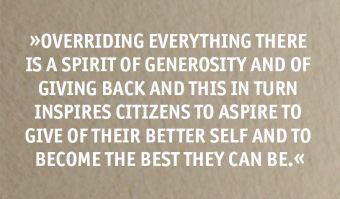
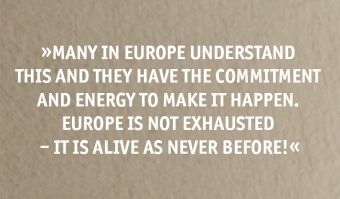
A place of inspiration and imagination
This place has a visionary feel. It lifts you up from the day-to-day. You feel at one with yourself and your city. It provides a heightened level of experience by its beauty, and what that is remains ever debatable—and so it is also a place of possibility and excitement. It allows you to envision what could be. Here, aspiration and good intent is made visible in both the built fabric and through the vitality of its culture and urban programming. Each reinforces the other and this creates a virtuous spiral. This visionary dimension reflects the ideals and ethics that the city wishes to project to its citizens and to the wider world. These greater purposes beyond self-interest change over time.
In bringing about a New Renaissance, three foci are important. First, we need to heal the division between the city and nature in a changing climate; second, we need to be imaginative in working through how we live together with our differences; and third, we need to unleash the creative potential in each one of us.
Many in Europe understand this and they have the commitment and energy to make it happen. Europe is not exhausted – it is alive as never before!
Charles Landry
Charles Landry works with cities around the world to help them make the most of their potential. He is widely acclaimed as a speaker, author, innovator and he facilitates complex urban change projects.His aim is to connect the triad culture, creativity and city making. An international authority on using imagination in creating self-sustaining urban change Charles has advised cities or given talks in over 60 countries. He helps shift how we harness possibilities and resources in reinventing our cities and his Creative City concept has become a global movement. His book The Art of City Making was voted the 2nd best book on cities ever written by the planning website: http://www.planetizen.com/node/66462. His most recent books are The Civic City in a Nomadic World and The Creative Bureaucracy with Margie Caust. The latter has become a movement with an annual festival taking place in autumn every year in Berlin. The 2021 Festival had over 18000 visitors. Other books cover the measurement of urban creativity, the digitized city, urban fragility and risk, the sensory experience cities and interculturalism. For further information: www.charleslandry.com
Picture © Lukas & Joe
